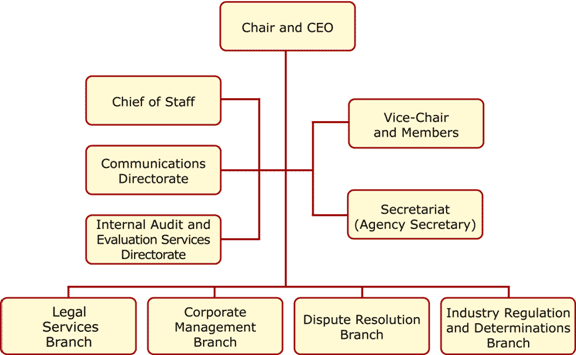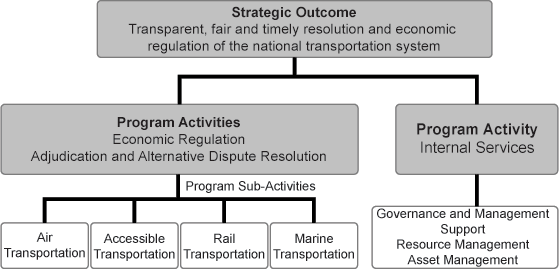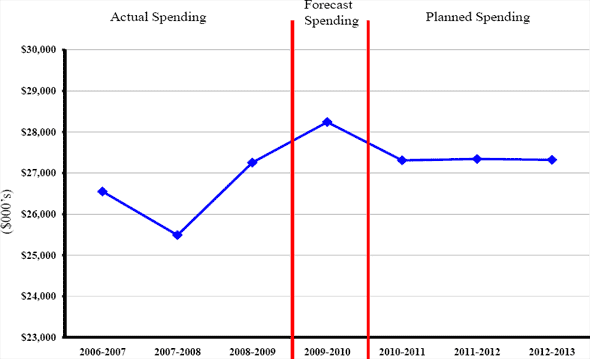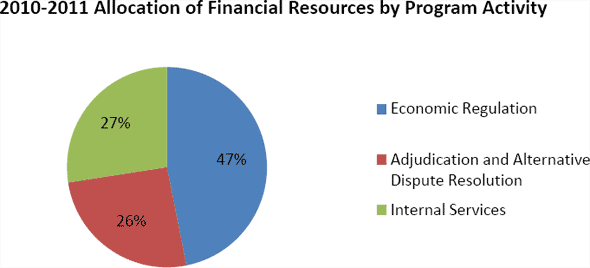Common menu bar links
Breadcrumb Trail
ARCHIVED - Canadian Transportation Agency
 This page has been archived.
This page has been archived.
Archived Content
Information identified as archived on the Web is for reference, research or recordkeeping purposes. It has not been altered or updated after the date of archiving. Web pages that are archived on the Web are not subject to the Government of Canada Web Standards. As per the Communications Policy of the Government of Canada, you can request alternate formats on the "Contact Us" page.
Chair's Message
It is my pleasure to present the Canadian Transportation Agency's 2010-2011 Report on Plans and Priorities. This document outlines how the Agency will continue to play its part in making transportation more efficient and accessible for all, contributing to the Government of Canada's objective of a fair and secure Canadian marketplace.
This planning period coincides with the final year of the Agency's Strategic Plan for 2008-2011. In addition to the annual review of its current plan and related initiatives, the Agency will establish priorities and actions for a new Strategic Plan to guide its work during 2011-2014.
The Agency will continue to pursue initiatives to advance the five strategic priorities identified in its three-year Strategic Plan. Most notably, the key focus areas for the Agency in the coming year will continue to be, alternative dispute resolution (ADR) processes, such as facilitation and mediation, and the modernization of its regulatory frameworks. ADR processes provide parties with effective and lower-cost options, while regulatory frameworks ensure that regulated parties are subject to clear, relevant and up-to-date requirements.
The Agency will sustain its focus on streamlining, clarifying and monitoring its decision-making processes so as to achieve its level of service targets.
To date, the Agency's level of service targets have been largely based on measurements of timeliness for its decisions. In 2010-2011, these targets will be complemented by extensive external client satisfaction research.
Concurrently with these core objectives, the Agency will pursue several other corporate initiatives to foster a more vibrant, accountable and responsive organization, including:
- the development and implementation of a comprehensive action plan to address issues raised by the Public Service Employee Survey and other feedback from staff;
- initiatives to improve external and internal communications, including finalizing the implementation of a client-centred inquiry service delivery model and the revamping of its intranet site; and
- initiatives to respond to management issues identified in the Management Accountability Framework (MAF) assessment.
Guided by its three-year Strategic Plan, the Agency has made great progress in advancing its identified priorities. The year 2010-2011 will be the last to be covered by this Plan, and I am confident that much of what we set for ourselves as objectives will be realized. This will set the foundation for the development of new objectives that will enable the Agency to continue as a leading tribunal that contributes to achieving a competitive, economic, efficient and accessible transportation system that enables economic growth. This is the ultimate objective that we at the Agency will continue working towards in 2010-2011.
Geoffrey C. Hare
Chair and Chief Executive Officer
Section I — Overview
1.1 Raison d'être
As an independent, quasi-judicial tribunal, the Agency makes decisions on a wide range of matters involving air, rail and marine modes of transportation under the legislative authority of Parliament and, for certain accessibility matters, extra-provincial bus transportation. Most of the Agency's activities and workload are generated by demand from users and operators of the national transportation system. The Agency implements the transportation policy established by Parliament in the Canada Transportation Act and other legislation. The tribunal's decision-making process is governed by its General Rules, which ensure that all parties to a complaint or an application are dealt with fairly and equitably.
The Agency's mission is to assist in achieving a competitive, efficient and accessible transportation system through dispute resolution, essential economic regulation and communication in a fair, transparent and timely manner.
1.2 Organizational Information
The Canadian Transportation Agency manages the economic regulation of air, rail and marine modes of transportation under the legislative authority of Parliament through the administration of laws, regulations, voluntary codes of practice, and educational and outreach programs, as well as through the resolution of disputes. It is an independent quasi-judicial administrative tribunal reporting to the Parliament of Canada through the Minister of Transport, Infrastructure and Communities.
The Agency exercises its powers through its Members, who are appointed by the Governor in Council (GIC). The GIC may appoint up to five full-time Members, including the Chair and Chief Executive Officer (CEO), and the Vice-Chair. The Minister of Transport, Infrastructure and Communities can also appoint up to three temporary Members.
The Members of the Agency are responsible for issuing quasi-judicial decisions and orders related to complaints or applications, as well as addressing other issues within the national transportation system.
The Chair and CEO is accountable for the Agency's three program activities. The Vice-Chair replaces the Chair and CEO during his absence. All Agency Members are accountable for making quasi-judicial decisions on matters before the Agency.
The Agency performs the functions vested in it by the Canada Transportation Act and related legislation (refer to section 3.2.3 for a list of legislation and regulations that the Agency administers in whole or in part). It operates within the context of the very large and complex Canadian transportation system (for details, refer to Transport Canada's Web site at http://www.tc.gc.ca).
The Agency is one of many Canadian partners helping to achieve transportation that works for everyone by contributing to a competitive and accessible transportation system that efficiently meets the needs of users and service providers and the Canadian economy. Its responsibilities include:
- Economic regulation, to provide approvals and licences, and make decisions on matters involving federally regulated air, rail and marine transportation;
- Dispute resolution, to resolve complaints about transportation services, rates, fees and charges; and
- Accessibility, to ensure that our national transportation system is accessible, particularly to persons with disabilities.
The Agency's organizational structure is composed of four branches: the Dispute Resolution Branch, the Industry Regulation and Determinations Branch, the Legal Services Branch, and the Corporate Management Branch. The heads of each branch, as well as the Communications Directorate, Internal Audit and Evaluation Services Directorate, and the Secretariat Directorate, report directly to the Chair and CEO. The organizational structure integrates a modal approach (air, accessible, rail, and marine) within a functional business delivery model and allows the Agency the flexibility to effectively deal with evolving workload and resource challenges while still meeting client-driven demands. This structure also creates greater career opportunities for learning and professional development, more variety in work assignments, and internal mobility for employees between directorates and branches.
Agency Organizational Chart

1.3 Strategic Outcome(s) and Program Activity Architecture
The Canadian Transportation Agency reports its plans, priorities and expected results to Parliament on the basis of its Program Activity Architecture (PAA). The PAA explains how the program activities and allocation of resources contribute to the Agency's strategic outcome:
Transparent, fair and timely dispute resolution and economic regulation of the national transportation system.
This is achieved through three program activities:
| Program Activity | Expected Result |
|---|---|
| Economic Regulation | Economic and other interests of transportation users, service providers and other affected parties are protected. |
| Adjudication and Alternative Dispute Resolution | Access to a specialized dispute resolution system that is cost-effective, responsive, fair and timely, and serves the needs of users, service providers and other affected parties within the national transportation system. |
| Internal Services | Support the needs of programs and other corporate obligations of the Agency. |

1.4 Expenditure Profile


*Note: In addition to corporate functions, Internal Services includes a portion of financial resources for common services, Internal Audit, Communications, Secretariat, and Legal Services.
Actual spending declined from $26.5 million in 2006-2007 to $25.4 million in 2007-2008 due to the elimination of funding for the Office of the Air Travel Complaints Commissioner, which was phased out over a three-year period beginning in 2005–2006.
From 2007-2008 to 2008-2009, actual spending increased from $25.4 million to $27.3 million as a result of the $1.1 million for the 2007-2008 carry-forward and $0.6 million for costs associated with the implementation of the new organization structure.
Forecast spending in 2009-2010 is around $1 million higher than 2008-2009 actual expenditures due to the 2008-2009 carry forward and the negotiation of collective agreements for various employee groups.
Planned spending for 2010-2011 and future years is lower than the 2009-2010 forecast spending by around $1 million as it does not reflect the Agency's maximum carry forward which is included in the 2009-2010 amount.
1.5 Planning Summary
1.5.1 Financial Resources ($ thousands)
| 2010-2011 | 2011-2012 | 2012-2013 |
|---|---|---|
| 27,311 | 27,343 | 27,322 |
1.5.2 Human Resources (full-time equivalents)
| 2010-2011 | 2011–2012 | 2012-2013 |
|---|---|---|
| 261 | 259 | 259 |
1.5.3 Link to the Government of Canada Outcome Areas
The Agency's strategic outcome and program activities are directly aligned with the broader Government of Canada outcome of “a fair and secure marketplace”. The regulatory programs implemented by the Agency resolve economic issues, remove transportation barriers and protect the rights of consumers, carriers and others. These programs also help to improve the overall quality of life in Canada, as an efficient and accessible transportation system that benefits all Canadians.
Strategic Outcome: Transparent, fair and timely dispute resolution and economic regulation of the national transportation system.
| Program Activity | Forecast Spending 2009-2010 | Planned Spending | Alignment to Government of Canada Outcome Area |
||
|---|---|---|---|---|---|
| 2010-2011 | 2011–2012 | 2012–2013 | |||
| Economic Regulation | 12,854 | 12,809 | 12,813 | 12,813 | A fair and secure marketplace |
| Adjudication and Alternative Dispute Resolution | 7,110 | 7,006 | 7,043 | 7,042 | |
Internal Services |
8,279 | 7,496 | 7,487 | 7,467 | |
| Total Planned Spending | 28,243 | 27,311 | 27,343 | 27,322 | |
*Note: The spending in 2010-2011 and thereafter includes collective bargaining.
1.5.4 Voted and Statutory Items in Main Estimates ($ thousands)
| Vote or Statutory Item | Truncated Vote or Statutory Wording | 2010-2011 Main Estimates | 2009-2010 Main Estimates |
|---|---|---|---|
| 25 | Program expenditures | 23,923 | 22,933 |
| (S) | Contributions to employee benefit plans | 3,388 | 3,219 |
| Total for the Agency | 27,311 | 26,152 |
Contribution of Priorities to Strategic Outcome
The Agency's Strategic Plan for 2008-2011 is based on the overarching strategic priority to maintain and enhance the Agency's long-standing reputation as a leading Canadian tribunal by committing to set and achieve high performance standards. The Agency reviews the Plan on an annual basis to ensure its key actions are in accordance with its priorities. Since the Agency is in its last year of its 2008-2011 Strategic Plan, the process for establishing strategic priorities and actions for 2011–2014 will take place in 2010.
For 2010-2011, the Agency will continue to focus on the five organizational priorities as outlined in its Strategic Plan:
Priority 1: Dispute Resolution and Economic Regulation
Responsive and effective dispute resolution The Agency acts early to define issues, to identify interests and to bring together the parties in a dispute. Through collaborative mechanisms, such as mediation, results will be achieved faster and more effectively, at less cost and with greater satisfaction and commitment to solutions. Where possible, the Agency encourages voluntary and informal processes to resolve disputes between parties as a more effective means of resolving disputes. Adjudicated cases are dealt with through an impartial, transparent, timely and fair process. |
Ongoing |
Supporting Program Activities: Dispute Resolution Internal Services |
Why this is a priority: Dispute resolution is one of the Agency's key business functions. The Agency strives to ensure that services are effective, responsive, fair and transparent, and weigh the interests of all parties in the national transportation system in a balanced manner. Key Plans: To maintain its reputation as an expert tribunal for transportation and human rights issues, the Agency will continue to issue balanced and fair decisions that are consistent with Agency precedents and that respect the decision of superior courts. |
Timely issuance of regulatory authorizations The national transportation policy encourages the market to regulate itself where competition exists; however, it acknowledges that regulation is necessary where parties are not served by effective competition or when other public interest requirements would not otherwise be met. The Agency issues administrative rulings and determinations, many of which are complex and unique, to support the effective regulation of the national transportation system. |
Ongoing |
Supporting Program Activities: Economic Regulation |
Why this is a priority: Economic regulation is one of the Agency's key business functions. The Agency has a mandate to administer economic regulatory provisions affecting modes of transport under federal jurisdiction as described in various Acts of Parliament. Key Plans: The Agency will modernize its regulatory frameworks to ensure they are up-to-date, relevant and clear, as well as manage its caseload in a sound, responsive, timely and efficient manner. |
Priority 2: People
Recruitment, retention and development of competent, capable and high performing staff In the next three years, a significant number of the Agency's staff will be eligible to retire. To ensure the transfer of corporate knowledge and expertise, “high risk” knowledge positions will be identified and mentoring and information retention and transfer initiatives will be implemented as part of a knowledge management plan. There will also be a focus on recruiting new employees, retaining and developing current staff and further engagement with all staff. |
Ongoing |
Supporting Program Activities: Economic Regulation Dispute Resolution Internal Services |
Why this is a priority: Employees are the Agency's greatest asset. To be recognized as a workplace of choice, the Agency strives to create a working environment that fosters staff engagement, innovation and creativity while providing development opportunities to attract and retain highly skilled individuals. Key Plans: The Agency intends to develop and implement plans for the retention and transfer of knowledge, implement targeted external recruitment strategies and demonstrate a commitment to employees' enrichment through enhanced learning opportunities. |
Priority 3: Enhanced Internal and External Communications
Enhanced communication and dialogue with employees, clients and stakeholders To establish productive and mutually beneficial relationships with its clients, its stakeholders and its employees, the Agency recognizes the need for clear and timely communications on its role, responsibilities, policies and procedures. It is adopting an approach that is co-ordinated and designed to improve its understanding of the issues and challenges facing its employees, clients and transportation service providers. |
Ongoing |
Supporting Program Activities: Economic Regulation Dispute Resolution Internal Services |
Why this is a priority: Open, timely and responsive communication and consultation with employees and stakeholders are integral to the Agency's ability to effectively carry out its mandate. Through regular open dialogue and feedback with employees and external clients and stakeholders, the Agency will improve its ability to identify and respond to their needs and, as a result, improve its overall work environment and service delivery. Key Plans: The Agency will analyze survey results measuring client satisfaction with its services to establish benchmarks. Subsequent surveys will be conducted and results will be used to drive service improvement delivery initiatives. The Agency will also enhance its Intranet and Web site to provide clear and timely information to meet the needs of employees, clients and stakeholders. |
Priority 4: Accessible Transportation
Improve the accessibility of the federally regulated transportation system The Agency uses a variety of mechanisms to improve the accessibility of the federally-regulated transportation system to persons with disabilities. It aims to eliminate problems before they occur by responding to pre-travel inquiries and by educating all parties regarding their rights and responsibilities. It develops and promotes regulations, codes of practice and standards that offer practical, functional and operation-oriented solutions. When disputes do occur, the Agency moves to resolve them quickly and encourages collaborative approaches where possible. |
Ongoing |
Supporting Program Activities: Economic Regulation Dispute Resolution |
Why this is a priority: The Agency has a legislative mandate to remove undue obstacles to the mobility of all persons, particularly those with disabilities. The Agency supports policy objectives set out in the Canada Transportation Act, which is to ensure that the federal transportation system is accessible to everyone. Key Plans: In order to ensure the continued improvement of accessible transportation, the Agency will target its monitoring activities; working with both industry and persons with disabilities to ensure compliance with Agency regulations and codes of practice; and continue to provide dispute resolution services. |
Priority 5: Organizational Support and Responsiveness
Continued effective governance and management processes and process improvements The Agency aims to ensure that it has strong governance, effective management principles and sound processes so that it can meet its other priorities in order to be a well-managed, innovative organization that anticipates and responds effectively to change. |
Ongoing |
Supporting Program Activities: Economic Regulation Dispute Resolution Internal Services |
Why this is a priority: The Agency is committed to meeting the accountability requirements of a federal government organization. Ensuring that the Agency is equipped with a comprehensive and integrated model for management and a commitment to continuous improvement will enable it to meet the accountability expectations of Parliament and Canadians. Key Plans: The Agency will continue to evaluate and streamline processes to ensure the effective management of resources, as well as adopting appropriate risk management practices and proactive budget processes in developing multi-year business plans. The Agency will also work towards the full implementation of its performance measurement framework while continuing to improve management practices through adherence and adoption of MAF practices. |
Risk Analysis
The Agency strives to maintain its reputation as an expert tribunal on transportation and human rights issues. This reputation is based on the Agency's independence from outside influence, the impartiality it has demonstrated in handling cases, the integrity and timeliness of its procedures, its expertise in transportation and human rights matters, and the deference that the Federal Court of Appeal and the Supreme Court of Canada have given to its past decisions. In order to maintain its reputation, the Agency must continue to be attentive to all these aspects of its role as a quasi-judicial administrative tribunal.
Providing the highest quality of service is a core value of the Agency and it demonstrates this commitment through the expertise and professionalism of its staff and by being responsive to its clients and stakeholders. To ensure this is continuously achieved, the Agency must measure client satisfaction to improve service delivery; promote ongoing dialogue with employees, clients and stakeholders to address their concerns; uphold standards for client service; ensure decisions are well-documented, drafted and supported; and modernize current regulations, guidelines and codes of practice.
As a demand-driven organization with a mandate dependent upon fulfilling service expectations of Canadians regarding transportation issues, the Agency must also ensure its ability to respond to changes in government policy, the external environment as well as the legislative mandate. Significant changes in these areas could impact the Agency's ability to respond quickly to meet client and stakeholder expectations because of limited resources and capacity.
The Agency continues to adjust to the full implications of its additional responsibilities, which include new provisions in the Act that provide shippers with greater recourse to obtain adequate and competitive service, as well as the mandate to hear complaints concerning rail noise and vibration. Although it is difficult for the Agency to foresee or predict potential changes to its environment, the Agency remains proactive in monitoring the effects of these changes on its current workload and will address any need for adjustments to its resource requirements. Through dialogue with stakeholders, the Agency will have the opportunity to adapt and to ensure that sufficient resources (financial and human) are appropriately allocated. Potential changes can also be determined through the Agency's involvement in the legislative and regulatory change process.
The retention of knowledge and expertise is critical to maintaining the level of service already provided, as well as adapting to its additional responsibilities. The changing demographics of the public service workforce and of the Agency's workforce in particular, present a significant human resource management challenge. Over the next few years, the Agency risks losing significant corporate knowledge and expertise as several long-term, key employees retire. In order to continue supporting its mandate, the Agency will focus its efforts on recruiting, retaining and developing highly competent staff with the capabilities to ensure that knowledge and expertise is retained and transferred.
The competitiveness of today's labour market requires that employees acquire and continuously update a skill set that allows them to reach their employment potential. This can result in the loss of invaluable and sometimes irreplaceable corporate knowledge and expertise as employees seek to fulfill and maintain such a skill set. The Agency will continue to emphasize the development of a wide range of skills, abilities and knowledge among its employees to minimize the loss when employees leave the organization. It will identify areas where the Agency is most vulnerable to the loss of critical business knowledge and expertise, ensure knowledge transfer and succession planning, and develop and maintain comprehensive procedures/manuals for retention of corporate knowledge.
A complete discussion of the Agency's risks and mitigation strategies can be found in its Corporate Risk Profile.
Opportunities and Challenges
The Agency, as part of efficient and effective economic regulation, continues its objective to modernize its regulations, guidelines and codes to ensure their continued currency. This objective is challenging because the Agency must at the same time, continue to manage its current caseload in a sound, responsive, timely manner; respond to unforeseen events and demands; and address transition issues related to an ageing workforce.
The Agency's workload is demand-driven and as such can vary. This, along with time and resource constraints, has presented challenges as the Agency strives to meet its deadlines and performance targets in issuing Agency decisions. One of the ways to meet this challenge is through the continued promotion of, and focus on, alternative dispute resolution (ADR). ADR methods can lead to a low-cost, effective and relatively quick settlement of the parties' issues.
In addition, the Agency has and will continue to review its formal adjudicative process to improve the timeliness of its decisions. As part of its review, an extensive analysis was undertaken of all the steps of the adjudicative process. The analysis demonstrated that the deadline for issuing decisions leaves little leeway for many of the procedural issues that are invariably raised in adjudication. Cases that are not resolved through informal methods tend to be more adversarial in nature, adding to the complexity that the Agency must deal with. There may also be cases that are without precedent or raise broad systemic or policy issues. Additional information and time may be required by the parties and interrogatories, and extensions of time are not uncommon. The Agency must also be able to take the time it needs to carefully consider and weigh the evidence before it. As such, the complexity of certain cases continues to present a challenge for the Agency in meeting its performance targets. As a preliminary response, a new legal business practice model has been adopted which integrates improvements in legal practices with line branch performance targets to better align legal resources with the Agency's organizational structure. There will also be increased focus on employee training, particularly on legal principles and processes specific to tribunal practices. In addition, the Agency will conduct a review of the Canadian Transportation Agency General Rules to identify revisions that would better respond to the differing needs of the Agency in disputes and determinations, as well as provide guidance to self-represented parties appearing before the Agency. Other initiatives will continue to be pursued to assist the Agency in addressing its workload and performance target challenges.
The Agency remains cognisant of its key environmental opportunities and challenges, and is proactive in developing its mitigation strategies.
